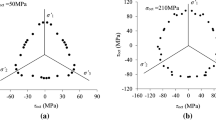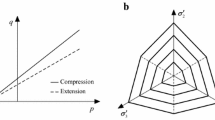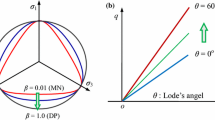Abstract
A three-dimensional nonlinear strength criterion for rocks considering both brittle and ductile domains is proposed through the combination of the segmented meridian function and a generalized deviatoric function with one parameter. The segmented meridian function is composed of the Hoek–Brown criterion, the smoothing transition surface, and the modified Drucker–Prager cap model. Besides, two deviatoric functions characterizing the smoothness and convexity based on the Matsuoka–Nakai criterion are suggested to describe the initial yield stage (brittle domain) and compaction yield cap stage (ductile domain). To verify the accuracy of the proposed strength criterion, six representative sets of true triaxial experimental data were selected from the existing literature, including two types of rocks, namely Dunham dolomite, KTB amphibolite, Mizuho trachyte, and Westerly granite that are independent of hydrostatic pressure in the brittle domain, and Bentheim sandstone and Castlegate sandstone which are dependent on hydrostatic pressure in the brittle–ductile domain. The results show that the experimental data are evenly distributed on the surface of the failure envelope in the three-dimensional principal stress space, demonstrating that the proposed strength criterion can accurately describe and predict the strength change of rocks in both brittle and ductile domains.
Highlights
-
A three-dimensional nonlinear strength criterion for rocks considering both brittle and ductile domains is proposed.
-
The segmented meridian function is composed of the Hoek–Brown criterion, the smoothing transition surface, and the modified Drucker–Prager cap model.
-
Two deviatoric functions characterizing the smoothness and convexity based on the Matsuoka–Nakai criterion are suggested to describe the initial yield stage (brittle domain) and compaction yield cap stage (ductile domain).















Similar content being viewed by others
Data Availability
Data will be made available on request.
References
Al-Ajmi AM, Zimmerman RW (2005) Relation between the Mogi and the Coulomb failure criteria. Int J Rock Mech Min Sci 42(3):431–439. https://doi.org/10.1016/j.ijrmms.2004.11.004
Benz T, Schwab R (2008) A quantitative comparison of six rock failure criteria. Int J Rock Mech Min Sci 45(7):1176–1186. https://doi.org/10.1016/j.ijrmms.2008.01.007
Bigoni D, Piccolroaz A (2004) Yield criteria for quasibrittle and frictional materials. Int J Solids Struct 41(11):2855–2878. https://doi.org/10.1016/j.ijsolstr.2003.12.024
Cai W, Zhu H, Liang W, Zhang L, Wu W (2021) A new version of the generalized Zhang-Zhu strength criterion and a discussion on its smoothness and convexity. Rock Mech Rock Eng 54(8):4265–4281. https://doi.org/10.1007/s00603-021-02505-z
Chang C, Haimson B (2000) True triaxial strength and deformability of the German Continental Deep Drilling Program (KTB) deep hole amphibolite. J Geophys Res Solid Earth 105(B8):18999–19013. https://doi.org/10.1029/2000jb900184
Chang C, Haimson B (2012) A failure criterion for rocks based on true triaxial testing. Rock Mech Rock Eng 45(6):1007–1010. https://doi.org/10.1007/s00603-012-0280-8
Chemenda AI, Mas D (2016) Dependence of rock properties on the Lode angle: Experimental data, constitutive model, and bifurcation analysis. J Mech Phys Solids 96:477–496. https://doi.org/10.1016/j.jmps.2016.08.004
Chen Y, Hu S, Wei K, Hu R, Zhou C, Jing L (2014) Experimental characterization and micromechanical modeling of damage-induced permeability variation in Beishan granite. Int J Rock Mech Min Sci 71:64–76. https://doi.org/10.1016/j.ijrmms.2014.07.002
Colmenares LB, Zoback MD (2002) A statistical evaluation of intact rock failure criteria constrained by polyaxial test data for five different rocks. Int J Rock Mech Min Sci 39(6):695–729. https://doi.org/10.1016/S1365-1609(02)00048-5
Descamps F, da Silva MR, Schroeder C, Verbrugge JC, Tshibangu JP (2012) Limiting envelopes of a dry porous limestone under true triaxial stress states. Int J Rock Mech Min Sci 56:88–99. https://doi.org/10.1016/j.ijrmms.2012.07.013
Feng X-T, Haimson B, Li X, Chang C, Ma X, Zhang X, Ingraham M, Suzuki K (2019) ISRM suggested method: determining deformation and failure characteristics of rocks subjected to true triaxial compression. Rock Mech Rock Eng 52(6):2011–2020. https://doi.org/10.1007/s00603-019-01782-z
Haimson B, Chang C (2000) A new true triaxial cell for testing mechanical properties of rock, and its use to determine rock strength and deformability of Westerly granite. Int J Rock Mech Min Sci 37(1):285–296. https://doi.org/10.1016/S1365-1609(99)00106-9
Haimson B, Rudnicki JW (2010) The effect of the intermediate principal stress on fault formation and fault angle in siltstone. J Struct Geol 32(11):1701–1711. https://doi.org/10.1016/j.jsg.2009.08.017
Heard HC (1960) Transition from brittle fracture to ductile flow in Solenhofen limestone as a function of temperature, confining pressure, and interstitial fluid pressure. Rock Deformation, Geological Society of America, pp 193-226
Hill R (1998) The mathematical theory of plasticity. Oxford University Press
Hoek E, Brown ET (1980) Empirical strength criterion for rock masses. J Geotech Eng Div 106(9):1013–1035
Hoek E, Brown ET (2019) The Hoek-Brown failure criterion and GSI—2018 edition. J Rock Mech Geotech Eng. 11(3):445–463. https://doi.org/10.1016/j.jrmge.2018.08.001
Hu S, Li X, Bai B (2018) Effects of different fluids on microcrack propagation in sandstone under true triaxial loading conditions. Greenh Gases 8(2):349–365. https://doi.org/10.1002/ghg.1744
Ingraham MD, Issen KA, Holcomb DJ (2013) Response of Castlegate sandstone to true triaxial states of stress. J Geophys Res Solid Earth 118(2):536–552. https://doi.org/10.1002/jgrb.50084
Jia L, Li B, Li J, Wang Z, Wu X, Gao Z, Cheng Q (2023) The effect of stress, pressure and temperature on CBM migration with elastic–plastic deformation. Geoenergy Sci Eng 221:211405. https://doi.org/10.1016/j.geoen.2022.211405
Lade Poul V, Duncan James M (1975) Elastoplastic stress-strain theory for cohesionless soil. J Geotech Eng Div 101(10):1037–1053. https://doi.org/10.1061/AJGEB6.0000204
Lee H, Haimson BC (2011) True triaxial strength, deformability, and brittle failure of granodiorite from the San Andreas Fault Observatory at Depth. Int J Rock Mech Min Sci 48(7):1199–1207. https://doi.org/10.1016/j.ijrmms.2011.08.003
Lee Y-K, Pietruszczak S, Choi B-H (2012) Failure criteria for rocks based on smooth approximations to Mohr-Coulomb and Hoek-Brown failure functions. Int J Rock Mech Min Sci 56:146–160. https://doi.org/10.1016/j.ijrmms.2012.07.032
Li H, Guo T, Nan Y, Han B (2021) A simplified three-dimensional extension of Hoek-Brown strength criterion. J Rock Mech Geotech Eng 13(3):568–578. https://doi.org/10.1016/j.jrmge.2020.10.004
Liolios P, Exadaktylos G (2017) Hyperbolic hardening model for quasibrittle materials. Int J Solids Struct 120:257–267. https://doi.org/10.1016/j.ijsolstr.2017.05.011
Ma X, Haimson BC (2016) Failure characteristics of two porous sandstones subjected to true triaxial stresses. J Geophys Res Solid Earth 121(9):6477–6498. https://doi.org/10.1002/2016jb012979
Ma X, Ingraham MD (2018) On the applicability of Nadai and Mogi failure criteria to porous sandstones. Rock Mech Rock Eng 51(12):3835–3843. https://doi.org/10.1007/s00603-018-1508-z
Ma X, Rudnicki JW, Haimson BC (2017a) The application of a Matsuoka-Nakai-Lade-Duncan failure criterion to two porous sandstones. Int J Rock Mech Min Sci 92:9–18. https://doi.org/10.1016/j.ijrmms.2016.12.004
Ma X, Rudnicki JW, Haimson BC (2017b) Failure characteristics of two porous sandstones subjected to true triaxial stresses: applied through a novel loading path. J Geophys Res Solid Earth 122(4):2525–2540. https://doi.org/10.1002/2016jb013637
Matsuoka H, Nakai T (1974) Stress-deformation and strength characteristics of soil under three different principal stresses. Proc Jpn Soc Civ Eng 1974(232):59–70. https://doi.org/10.2208/jscej1969.1974.232_59
Nayak GC, Zienkiewicz OC (1972) Convenient form of stress invariants for plasticity. J Struct Div 98(4):949–954
Piccolroaz A, Bigoni D (2009) Yield criteria for quasibrittle and frictional materials: a generalization to surfaces with corners. Int J Solids Struct 46(20):3587–3596. https://doi.org/10.1016/j.ijsolstr.2009.06.006
Priest SD (2005) Determination of shear strength and three-dimensional yield strength for the hoek-brown criterion. Rock Mech Rock Eng 38(4):299–327. https://doi.org/10.1007/s00603-005-0056-5
Priest S (2012) Three-dimensional failure criteria based on the Hoek-Brown criterion. Rock Mech Rock Eng 45(6):989–993. https://doi.org/10.1007/s00603-012-0277-3
Shin H, Kim J-B (2015) Physical interpretations for cap parameters of the modified Drucker-Prager cap model in relation to the deviator stress curve of a particulate compact in conventional triaxial testing. Powder Technol 280:94–102. https://doi.org/10.1016/j.powtec.2015.04.023
Song Z, Yin G, Ranjith PG, Li M, Huang J, Liu C (2019) Influence of the Intermediate Principal Stress on Sandstone Failure. Rock Mech Rock Eng 52(9):3033–3046. https://doi.org/10.1007/s00603-019-01756-1
Wilkins A, Spencer BW, Jain A, Gencturk B (2020) A method for smoothing multiple yield functions. Int J Numer Methods Eng 121(3):434–449. https://doi.org/10.1002/nme.6215
Wong T-F, Baud P (2012) The brittle-ductile transition in porous rock: a review. J Struct Geol 44:25–53. https://doi.org/10.1016/j.jsg.2012.07.010
Wu S, Zhang S, Guo C, Xiong L (2017) A generalized nonlinear failure criterion for frictional materials. Acta Geotech 12(6):1353–1371. https://doi.org/10.1007/s11440-017-0532-6
Wu S, Zhang S, Zhang G (2018) Three-dimensional strength estimation of intact rocks using a modified Hoek-Brown criterion based on a new deviatoric function. Int J Rock Mech Min Sci 107:181–190. https://doi.org/10.1016/j.ijrmms.2018.04.050
Xie H, Gao M, Zhang R, Peng G, Wang W, Li A (2019) Study on the mechanical properties and mechanical response of coal mining at 1000m or deeper. Rock Mech Rock Eng 52(5):1475–1490. https://doi.org/10.1007/s00603-018-1509-y
Xu Y, Xiao J, Li X, Xia K, Peng J (2023) Experimental study on the permeability evolution of argillaceous sandstone under elevated temperatures. Eng Geol. https://doi.org/10.1016/j.enggeo.2022.106974
Zhang L, Zhu H (2007) Three-dimensional Hoek-Brown strength criterion for rocks. J Geotech Geoenviron Eng 133(9):1128–1135. https://doi.org/10.1061/(asce)1090-0241(2007)133:9(1128)
Zhang Q, Zhu H, Zhang L (2013) Modification of a generalized three-dimensional Hoek-Brown strength criterion. Int J Rock Mech Min Sci 59:80–96. https://doi.org/10.1016/j.ijrmms.2012.12.009
Zhang S, Wu S, Zhang G (2020) Strength and deformability of a low-porosity sandstone under true triaxial compression conditions. Int J Rock Mech Min Sci. https://doi.org/10.1016/j.ijrmms.2019.104204
Zhang N, Li X, Wang D (2021) Smoothed Classic Yield Function for C2 Continuities in Tensile Cutoff, Compressive Cap, and Deviatoric Sections. Int J Geomech. https://doi.org/10.1061/(asce)gm.1943-5622.0001910
Acknowledgements
This work has been sponsored by the Xiongan New Area Science and Technology Innovation Project under Grants 2022XAGG0400 and CNPC Innovation Found under 2022DQ02-0610. We also acknowledge the financial support by the National Natural Science Foundation of China under Grants #42141010 and the Fundamental Research Funds for the Central Universities (CUGB).
Author information
Authors and Affiliations
Corresponding author
Ethics declarations
Conflict of Interest
The authors declare that they have no known competing financial interests or personal relationships that could have appeared to influence the work reported in this paper.
Additional information
Publisher's Note
Springer Nature remains neutral with regard to jurisdictional claims in published maps and institutional affiliations.
Rights and permissions
Springer Nature or its licensor (e.g. a society or other partner) holds exclusive rights to this article under a publishing agreement with the author(s) or other rightsholder(s); author self-archiving of the accepted manuscript version of this article is solely governed by the terms of such publishing agreement and applicable law.
About this article
Cite this article
Liu, J., Li, X., Xu, Y. et al. A Three-Dimensional Nonlinear Strength Criterion for Rocks Considering Both Brittle and Ductile Domains. Rock Mech Rock Eng (2024). https://doi.org/10.1007/s00603-024-03823-8
Received:
Accepted:
Published:
DOI: https://doi.org/10.1007/s00603-024-03823-8




